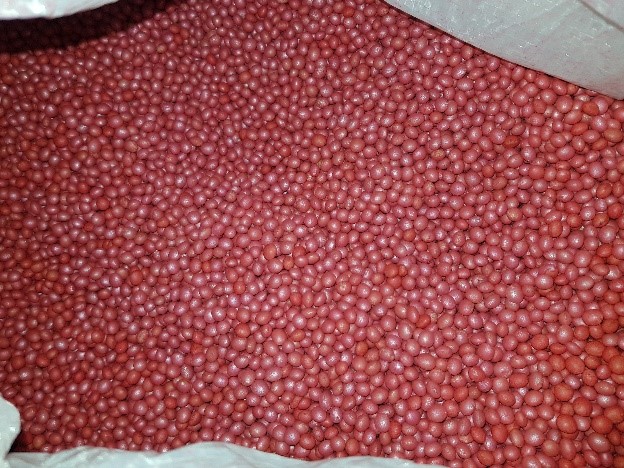In the past 14 years I’ve worked in agriculture, I’d say no segment of the business has changed as rapidly as soybean seed treatments. At the beginning of my career, it wasn’t uncommon to have growers planting 180,000 – 240,000 untreated soybean seeds per acre to get a full stand of soybeans. Today, it’s common practice in my part of the state for planters to be set to drop 120,000 – 150,000 treated soybeans per acre and achieve better, healthier stands than ever. Seed treatments are 100% to thank for this shift in practices.

So, what exactly is a seed treatment? “Full treatment” has become sort of a catch-all term that I feel adds confusion to the subject. What most people refer to as “full treatment” really only covers what I consider 2 out of the 6 segments of seed protection and enhancement. Considering the safe range of liquid to apply to a unit of soybeans is 3.5 – 4 fluid ounces, you’d be hard pressed to apply a “full” seed treatment covering all 6 segments. I find it best to think of treatments as an a la carte approach. When ordering seed treatment, it’s a good idea to think about what areas you’re needing protection and looking for enhancement. Let’s take a brief look at each of the 6 segments.
- Fungicide: This is the base of every seed treatment on the market. Fungicides give you protection against seedling and early season diseases such as Phytophthora and Pythium, which are annual pests. Some fungicides are known to increase seed germination percentages above labeled rates, sometimes substantially.
- Insecticide: Commonly, neonicotinoids are applied to seed to protect against early season insect feeding from pests such as bean leaf beetles. Insecticide treatment is more important in early plant scenarios when soybeans will be slow growing and susceptible to vegetative feeding for longer periods of time. Some insecticide treated soybeans also have shown increased early season vigor. It is worth considering that there is replicated University data showing in no-till or cover crop scenarios with high residue, slug damage to beans is increased if a seed applied insecticide is used. Slugs are a mollusk and accumulate insecticide in their bodies, when predatory insects try to feed on the slugs the predators are killed by the insecticide.
- Nematicide: These provide early season protection against nematodes, microscopic worms that feed on soybean roots.
- Sudden Death Syndrome (SDS): These are a specialized class of fungicide treatments which protects soybeans against SDS. Some products also protect against certain nematodes. Be cautious about what you are getting when you get some of these products. Occasionally, you’ll hear of someone selling them far cheaper than others in the marketplace. Generally, they’re selling the lowest rate, offering nematode protection and not protection against SDS.
- Plant Growth Regulators (PGRs): Commonly referred to as PGRs, these compounds are synthetic or naturally derived extracts which cause plants to grow faster. When applied in a seed treatment, faster emergence and early season vigor can be seen.
- Inoculants and Biologicals: This class of seed treatments contains living microbes which will colonize the root system of the developing plants. The most common are nitrogen fixing rhizobia bacteria inoculants. Generally, special care needs to be taken so the living organisms on the seed make it to the soil with the seed alive. These should be strongly considered if planting soybeans after years of continuous corn.
I hope this helps you decide which levels of protection and enhancement are right for your operation. Your local certified crop advisor and seed dealer can help you decide which products are right for your operation. Remember, just because treated soybeans look the same doesn’t mean they are!
 So, what exactly is a seed treatment? “Full treatment” has become sort of a catch-all term that I feel adds confusion to the subject. What most people refer to as “full treatment” really only covers what I consider 2 out of the 6 segments of seed protection and enhancement. Considering the safe range of liquid to apply to a unit of soybeans is 3.5 – 4 fluid ounces, you’d be hard pressed to apply a “full” seed treatment covering all 6 segments. I find it best to think of treatments as an a la carte approach. When ordering seed treatment, it’s a good idea to think about what areas you’re needing protection and looking for enhancement. Let’s take a brief look at each of the 6 segments.
So, what exactly is a seed treatment? “Full treatment” has become sort of a catch-all term that I feel adds confusion to the subject. What most people refer to as “full treatment” really only covers what I consider 2 out of the 6 segments of seed protection and enhancement. Considering the safe range of liquid to apply to a unit of soybeans is 3.5 – 4 fluid ounces, you’d be hard pressed to apply a “full” seed treatment covering all 6 segments. I find it best to think of treatments as an a la carte approach. When ordering seed treatment, it’s a good idea to think about what areas you’re needing protection and looking for enhancement. Let’s take a brief look at each of the 6 segments.



 and then
and then